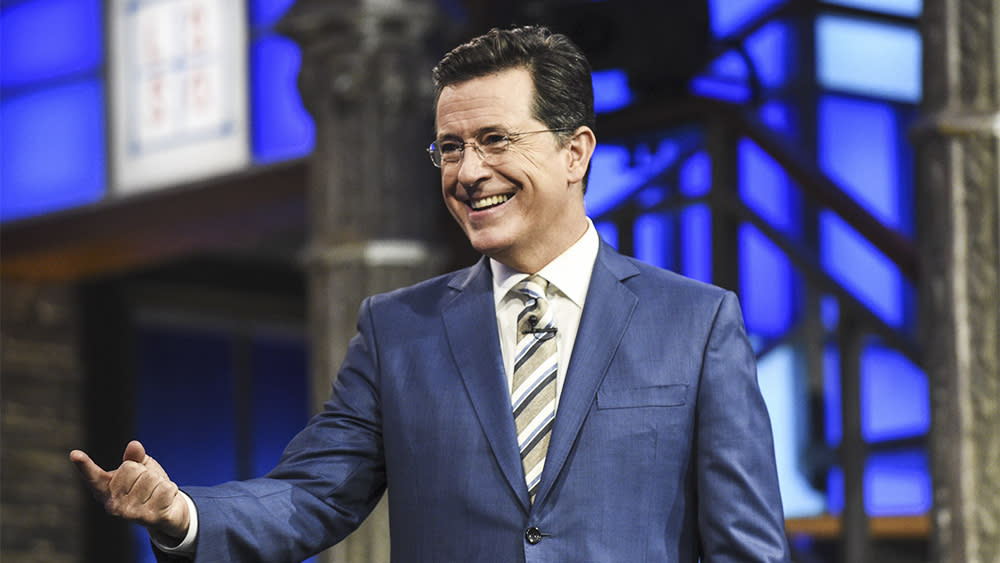Stephen Colbert Plans to Conquer the Social Web

In a different era, Stephen Colbert might have been kicking himself: On Thursday, he and his “Late Show” team taped an episode to be broadcast on CBS the next night, a move that should have left him unable to comment on one of the craziest episodes ever to surface in the race for the White House.
Yet just as the nation was looking for pundits to weigh in on a 2005 “Access Hollywood” outtake showing Donald Trump talking to host Billy Bush about sexually harassing women, there was Colbert – on Twitter. From his home, Colbert explained the situation to followers and invited them to watch him as he watched the tape. As Trump talked to Bush about grabbing women’s genitals and popping breath mints so he could kiss attractive celebrities, Colbert put his head in his hand. “All the Tic-Tacs in the world will not freshen his breath after this,” the late-night host quipped.
Fans should gear up for more digital-only appearances from the wee-hours host. “Stephen really wants to be a part of the conversation as much as he can, so I would say to look for Stephen in digital ways that are not on the actual show,” said Chris Licht, who supervises production of CBS’ “The Late Show.” “You’ll see more of him online exclusively.”
Colbert’s team is placing more emphasis on venues such as Facebook, Snapchat and Twitter at a time of furious competition. Many fans of Colbert and contemporaries like Jimmy Fallon and Jimmy Kimmel turn to clips of the shows that get passed around on social media and streaming video rather than tuning in to the programs themselves. Where hosts like Jay Leno and David Letterman could focus almost entirely on their broadcasts, a new raft of late-night presenters – a wave that might be dubbed “Carson 3.0″) – are forced to occupy themselves with distributing new segments in non-traditional ways.
Others are working just as furiously as Colbert. The team from TBS’ “Full Frontal” on Friday evening also got in on the Trump gaffe by posting a video on Twitter purporting to show Samantha Bee, the program’s host, having a lewd conversation about male genitals. A fake letter of apology was posted in tandem. At Comedy Central, Trevor Noah’s “Daily Show” has tested technology ranging from Snapchat to Amazon’s Alexa.
To be sure, Colbert has long maintained an online presence. Before his new CBS program debuted in September of last year, he posted online videos to keep fans intrigued while he transitioned from his previous roost on Comedy Central. But there have been critiques that Colbert’s currency material – rooted deeply in the news of the day rather than the pranks and wild games that are so much a part of late night TV these days – don’t always get the pass-along accorded rivals in the space. A recent broadcast devoted almost entirely to an interview with Bruce Springsteen was riveting, but is it the sort of stuff that breaks the Internet?
“It’s important for the show to be relevant, and something going viral or having a big digital footprint is a symptom of being relevant,” said Licht. “The medium has changed. Late night shows have always been judged on their relevancy and now the metric is how do you do it digitally.”And he pointed out that the Boss did get digital pass-along in the form of a segment in which Colbert asked the rock star about his picks for his five best songs.
Some of the team’s digital efforts, led by an eight-person team working with CBS Interactive, has already surfaced. Jon Batiste and Stay Human, the “Late Show” band, took viewers on a 30-minute musical walk down Broadway, courtesy of Facebook Live. During the recent Republican National Convention, the “Late Show” team set up a live stream of a condiment stations and caught Fox News Channel anchor Bret Baier hoarding mustard in a water bottle.
One of the show’s latest escapades sparked robust social activity. During the recent debate between vice-presidential candidates Tim Kaine and Mike Pence, “Late Show” live-streamed a “kitten cam” via Facebook that showed a “focus group” of kittens taking in the match-up. Viewers were urged to catch a live “Late Show” broadcast set to air after the debate. After about 90 minutes of feline antics, Colbert himself turned up for a few moments. The video generated more than one million views in a single evening.
The aim is to make Colbert’s humor available to potential viewers even when his broadcasts are not on TV. “There is new attention on the strategy,” said Marc DeBevoise, president and chief operating officer of CBS Interactive. “There is a new way to engage with fans at times when they might be doing something else.”
There is no desire to reduce focus on the TV program, executives said. “I don’t feel like we feel too much pressure to have this need to be viral,” said DeBevoise “More important is the authentic link to the audience.”
The renewed emphasis on digital outreach comes after CBS put in place a new management structure at “The Late Show” that made Licht, who developed the new edition of “CBS This Morning,” an executive producer and a partner for Colbert. Digital “was always a priority” for “Late Show,” said Licht. “In these last few months, we’ve been able to just give it the attention everyone always knew it deserved.”
Related stories
Donald Trump: Stephen Colbert, Bill Maher, Samantha Bee React to GOP Nominee's Vulgar Comments
Stephen Colbert's 'Late Show' Develops a Taste for Bud Light
Stephen Colbert Parodies 'Fifty Shades Darker' Trailer [VIDEO]
Get more from Variety and Variety411: Follow us on Twitter, Facebook, Newsletter
